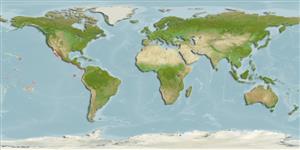>
Eupercaria/misc (Various families in series Eupercaria) >
Labridae (Wrasses) > Corinae
Etymology: Halichoeres: Greek, als, alis = salt + Greek, choiros = pig (Ref. 45335).
More on author: Günther.
Environment: milieu / climate zone / depth range / distribution range
Écologie
marin récifal; profondeur 0 - 10 m (Ref. 9311). Tropical; 32°N -
Eastern Pacific: Bahía Magdalena, Mexico south to Peru, including the Galapagos Islands.
Taille / Poids / Âge
Maturity: Lm ? range ? - ? cm
Max length : 25.4 cm TL mâle / non sexé; (Ref. 5592); common length : 15.0 cm TL mâle / non sexé; (Ref. 55763)
Common in shallow waters, especially where brown algae exists (Ref. 9311). Diet consists of crustaceans, sea urchins, mollusks, and brittle stars. It loses its blue-green coloration, turns dull brown in captivity.
Life cycle and mating behavior
Maturité | Reproduction | Frai | Œufs | Fécondité | Larves
Distinct pairing during breeding (Ref. 205).
Thomson, D.A., 1987. Reef fishes of the Sea of Cortez. The rocky-shore fishes of the Gulf of California. The University of Arizona Press, Tucson. 302 p. (Ref. 5592)
Statut dans la liste rouge de l'IUCN (Ref. 130435)
Menace pour l'homme
Harmless
Utilisations par l'homme
Plus d'informations
RéférencesAquacultureProfil d'aquacultureSouchesGénétiqueElectrophoresesHéritabilitéPathologiesTraitementNutrientsMass conversion
CollaborateursImagesStamps, Coins Misc.SonsCiguateraVitesseType de nageSurface branchialeOtolithesCerveauxVision
Outils
Articles particuliers
Télécharger en XML
Sources Internet
Estimates based on models
Preferred temperature (Ref.
123201): 22.4 - 29.1, mean 26.8 °C (based on 245 cells).
Phylogenetic diversity index (Ref.
82804): PD
50 = 0.5000 [Uniqueness, from 0.5 = low to 2.0 = high].
Bayesian length-weight: a=0.00955 (0.00451 - 0.02020), b=3.09 (2.92 - 3.26), in cm total length, based on LWR estimates for this Genus-body shape (Ref.
93245).
Niveau trophique (Ref.
69278): 3.5 ±0.43 se; based on food items.
Résilience (Ref.
120179): Milieu, temps minimum de doublement de population : 1,4 à 4,4 années (Preliminary K or Fecundity.).
Fishing Vulnerability (Ref.
59153): Low vulnerability (15 of 100).
Nutrients (Ref.
124155): Calcium = 64.9 [38.4, 108.0] mg/100g; Iron = 0.625 [0.358, 1.166] mg/100g; Protein = 18.6 [15.8, 20.9] %; Omega3 = 0.128 [0.081, 0.199] g/100g; Selenium = 20.2 [12.2, 37.0] μg/100g; VitaminA = 126 [38, 457] μg/100g; Zinc = 1.53 [1.07, 2.41] mg/100g (wet weight);
